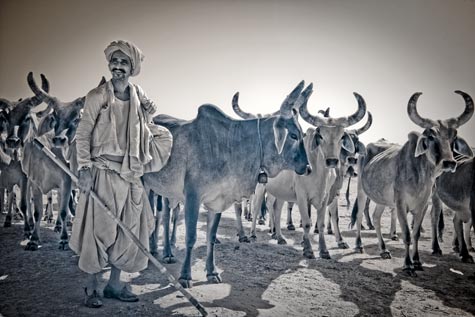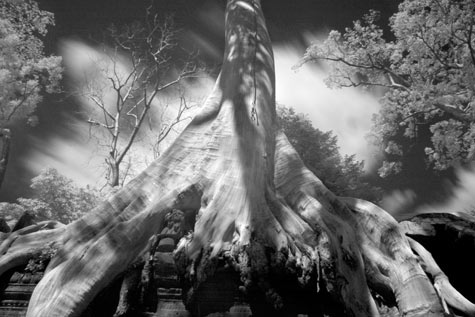Magazine
Lee Grant is an Australian photographer just graduating with her Masters from the Australian National University. Based in Canberra, Lee has produced several bodies of work from which this edit was made, including 'Sudanese Portraits From Suburbia' which documents this growing population of immigrants and 'Belco Pride' about the northernmost suburbs of Canberra. Lee is featured in the new book 'Hijacked 2, New Australian and German Photography', and is the recent winner of the prestigious William and Winifred Bowness Photography Prize at Monash Gallery of Art in Melbourne.
Lee is also the curator of Light Journeys, a new website that promotes and supports Australian women working in photography.
View the full screen magazine photo feature.
On the Artists Wanted website, a woman photographing her son dressed as a girl piqued my interest.
"Photography was a way of being able to participate in a world where I didn't normally feel I fit in. I started photographing my children but quickly became known for capturing other people's children as they were seen by their parents. I was in love with the challenge and process of connecting with my subjects. No matter how a photo shoot started, there was always mutual trust and respect by the end. Through this process I learned that energy, positive energy, is contagious, and what I was searching for in my life was coming through in my images.
'The Many Faces of Hambone' was inspired by my mother's shallowness and how the emphasis on appearance stunted my emotional and spiritual growth. These images of my 9 year old son best illustrate my intent to show that a beautiful child does not translate into beauty within. I thank my mother now as I understand her own insecurities and lack of love for herself kept her from accepting me. It has taught me to appreciate my life and has inspired me to be a better mother, person and artist. He is not going to be a cross dresser or gay because I dressed him up; he is going to be a beautiful, independent, confident human being because I adore and accept him for who he is. I believe the photographs are beautiful, and my son looks pretty darn cute and convincing as a girl; the images individually and as a series are purposely and consistently meant to be emotionless and non contagious. The audience emotionally should be left wanting more." - Hilary Mullarkey, September 2010
View the magazine full screen photo feature.

Nick Gleis is clearly a prolific photographer of craft. He has provided photographic images for heads of state and royalty worldwide including Japan, South Korea, UAE, Turkmenistan, Dubai, Cameroon, Mexico, and China - his expertise lies in photographing the most exclusive private jet aircraft. With Martin Parr having selected Nick's work for exhibit at the upcoming Brighton Photo Festival in England, and with his photographs being published around the world, Nick agreed to publish these images full screen in aCurator. With understandable sensitivity to the privacy of the clients, we know little about who and where; we can only gasp at the sheer opulence and let our imaginations run wild within the frame.
Nick sent in a statement: "In the last decade the field of photography has seen a complete revamp in the way we do things. When I was studying photography with Ansel Adams and other noted photographers there was an important phrase which I believe was first stated by Minor White. 'When combined with The Zone System, pre-visualization makes the photographer's vision a reality.' Ansel had developed a method of exposure, development and printing that produced what the photographer intended to be seen. It wasn't necessarily a literal version of what was there. Pre-visualization is the photographer's vision of the final image.
This pre-visualization is the single most important step to achieving a great image in today's world. Pre-visualizing the final outcome - then assembling the necessary elements - is the way to create lasting images, whether one is photographing an aircraft or a sports car. Virtually all photographs taken by me involve pre-visualization. Far too many photographers today rely on digital tricks and software to produce technically good images, but images that neither excite nor inform the viewer. I would advise all up and coming photographers to slow down and look at the scene very carefully. Is there a better angle? Is the lighting optimal? After all, lighting is everything." - Nick Gleis, September 2010
Stretch DC-8 © Nick Gleis
I noticed Leah Giesler following me on Twitter, and visiting her website I found a young woman from Philadelphia undertaking a wonderful project - traveling across South America taking photographs for 25 non-profit organizations while she's 25 years old. I'm pleased to present a selection from her series in Colombia.
"The 25twenty-five Project is a long-term, online, documentary photo series telling stories across and about South America. I am creating a space to re-imagine this continent by combining poignant photo essays about 25 non-profit organizations along side of other contextual cultural observations, posted to a bilingual website.
My motivation for the 25twenty-five Project comes from my interest in finding creative, effective forms to adapt the way we Westerners look at others around the world. After completing a project working to this end with images from India, I wanted to move onto a new challenge and tackle the misunderstood and under-imagined continent of South America. So, I created the 25twenty-five Project in order to educate and engage audiences over the course of one year and ask the question, how much do North Americans really know about this 'other America'?
By consistently posting these works to the 25twenty-five bilingual website over the span of one year, I will be gradually illustrating more positive parts of these countries and creating a dialog that travels between the two Americas. So many of us North Americans lack relation and consideration to the countries and people of South America. And often, when we have no information to go off in imagining this place, we rely on the negative information we do have. Through this project, I will be gradually building a new (and more positive) relationship between both North and South American audiences."
View the full screen magazine photo feature
Basic pediatric exam, Corporación Condor, Providencia © Leah Giesler

From the new book by Aperture Foundation.
"On the fifth anniversary of the storm, 'Destroy This Memory', photographs by Richard Misrach, offers unique, revealing human perspectives on the devastation and shock left in the wake of Hurricane Katrina. 'Destroy This Memory' presents previously unpublished and starkly compelling material, all of which Misrach shot with his 4 MP pocket camera. Created between October and December 2005, this haunting series of images serves as a potent, unalloyed document of the raw experiences of those left to fend for themselves in the aftermath of Katrina."
Artist's royalties for this project are being donated to the Make It Right Foundation, which is currently rebuilding the Lower Ninth Ward of New Orleans.
The images truly speak for themselves, containing the only text in this heart-breaking series.
View the magazine full screen photo feature.
Buy the book.
Exhibitions: Museum of Fine Arts Houston, August 7 - October 31, 2010
New Orleans Museum of Art, August 28 - October 24, 2010
Artist's Lecture and Book Signing
August 29, 2:00 pm
© Richard Misrach

aCurator is proud to support Aperture Foundation.
"Following the success of 2005's groundbreaking book and exhibition 'reGeneration: 50 photographers of tomorrow', 'reGeneration²: tomorrow's photographers today' turns the spotlight yet again on the next generation of potential stars. reGeneration² proves that the art of photography is alive and well, and that practitioners of extraordinary talent are well on their way to making their mark. The selection was made with one key question in mind: is the photographer likely to be known in twenty years' time?
Through over two hundred images, reGeneration² showcases the inspiring creativity and ingenuity of eighty up-and-coming photographic artists. The variety of subjects and techniques on view in this remarkable reflects the astonishing diversity of worldwide talent that has newly emerged. Useful reference materials include biographical details of each of the eighty photographers included and updates on the winning photographers from the first edition, many of whom have since forged impressive international careers, including Pieter Hugo, Idris Khan, Angela Strassheim, and Nathalie Czech."
View the magazine full screen photo feature.
The Cloud, 2008 © Liu Xiaofang from the Aperture book entitled reGeneration²
"Following the success of 2005's groundbreaking book and exhibition 'reGeneration: 50 photographers of tomorrow', 'reGeneration²: tomorrow's photographers today' turns the spotlight yet again on the next generation of potential stars. reGeneration² proves that the art of photography is alive and well, and that practitioners of extraordinary talent are well on their way to making their mark. The selection was made with one key question in mind: is the photographer likely to be known in twenty years' time?
Through over two hundred images, reGeneration² showcases the inspiring creativity and ingenuity of eighty up-and-coming photographic artists. The variety of subjects and techniques on view in this remarkable reflects the astonishing diversity of worldwide talent that has newly emerged. Useful reference materials include biographical details of each of the eighty photographers included and updates on the winning photographers from the first edition, many of whom have since forged impressive international careers, including Pieter Hugo, Idris Khan, Angela Strassheim, and Nathalie Czech."
View the magazine full screen photo feature.
The Cloud, 2008 © Liu Xiaofang from the Aperture book entitled reGeneration²

"'One Block', Anderson's third show at ClampArt, is a powerful body of work which follows the reconstruction of a single New Orleans block in the wake of Hurricane Katrina, delivering a compelling portrait of the storm's ongoing physical and psychological impact on the city and its residents. Using portraiture, still life, and abstract images, Anderson documents the evolution of both the street and its houses as residents literally rebuild their lives, exploring the very nature of community while testing its resilience.
Anderson's compassionate treatment of the neighborhood's straitened financial circumstances and its courageous reconstruction has drawn comparisons to coverage of the Great Depression by Dorothea Lange, Walker Evans, and other Farm Security Administration-funded photographers. Seventy years later, between the devastation of Hurricane Katrina and the crippling recession, the stability and permanence of the American home is once again at stake." - ClampArt
'One Block' is exhibited at ClampArt through August 20th and the monograph is now available from Aperture.

"My ongoing body of work, 'Still Points in a Turning World', explores our universal cross-cultural truths: the importance of family, community, ritual and the amazing diversity of its expression.
My earliest memories are of spinning a globe, always drawn to the last mysterious corners of the world. Photographing the people, festivals and sacred sites in the tribal areas of Asia, my passion is to visually capture the rituals that define our lives and to create images that explore our human connections as they are formed. This series is from my travels in the Winter of 2010 to Southern Rajasthan & Gujarat exploring the tribal cultures of the Rabaris, Garasias, Bhils, Wadha and the reclusive Jats. Highlights of the trip were visiting villages where the traditions of different millennia co-exist side by side and the Baneshwar Mela where the tribal Bhil women performed early morning bathing rituals.
My work is interpretive in nature. The photograph is the first step in the process. My technique often involves creating imagery using the invisible infrared light spectrum. I shot infrared film for many years. Now, I use a digital camera converted to infrared and the digital darkroom to create the split-toned imagery. It adds an element of mystery when creating the work, which, I feel, suits the subject matter and the timeless quality of the images.
The differences between our many world cultures are fading away. We all lose when ancient skills and visionary wisdom are forgotten. As a 'visual archeologist', photography has become my way to honor and celebrate an existence that may soon vanish and what it is that makes a people unique. I believe that sharing these stories and rituals can have a positive impact by providing a window on our common humanity." - Terri Gold, July 2010
View the magazine photo feature.
Gujarati Shepherd © Terri Gold

"I stumbled upon this a few summers ago while driving out to the beach, taking the back roads through Brooklyn. As I sped down the Highway I thought I caught a glimpse of these two black cowboys, trotting out on the grassy strip alongside the road. I was going too fast to get a good look, and there was nowhere to turn around but I went back a few days later, and found this unbelievable place. It's a few acres of land which consists of horse stables (they have about 30-40 horses that live there year round), a riding ring, a bunch of junked up trailers, a clubhouse (which was shut down by the DOB last I saw), and a large grassy area. The people I met there were very welcoming, mostly of an older generation, mostly from the south, and consider themselves real cowboys.
The place is really special because it's nothing like New York City, yet it's really buried deep in the boroughs - right by East New York, Howard Beach, and Ozone Park. But when you're standing there, you really feel like you could be in South Carolina or some far off place." - Dennis Kleiman, July 2010
"The Federation of Black Cowboys was created in 1994 by a group of diverse people looking to share and promote knowledge of the 'Black West'. Seeking to create greater understanding of African American culture and heritage, we endeavor to provide educational opportunities for the young public of New York."

"I became fascinated by the life-and-death survival struggle of the trees of Angkor and the ancient temples upon which they grow. I used infrared filters and slow shutter speeds to capture the otherworldly light and power of the trees." - Viviane Moos.
The temples of Angkor were built by the Khmer civilization between 802 and 1220 AD. From Angkor the Khmer kings ruled over a vast domain that reached from Vietnam to China to the Bay of Bengal. More than 100 stone temples survive. Angkor Wat, built during the early years of the 12th century honors the Hindu god Vishnu and is a symbolic representation of Hindu cosmology.
Recent Entries
Categories
Links
Julie Grahame Photographer Consulting Services
Archive
Accent Magazine
Life.com Top Photo Blogs
AdobeAirStream
Aglu Pocket Photo Books & Photographs
APA American Photographic Artists
Aperture
ASMP America Society of Media Photographers
bigflannel
Café Royal Books
Chatterbox
ClampArt
Conscientious
Crusade For Art
Daylight Magazine
eyecurious
Featureshoot
FlakPhoto
Fototazo
ILOVETHATPHOTO
Interview by Dirk Anschutz
Interview by Miss Rosen
Interview by SlideShowPro
Jason Florio
Jealous Curator
Jeriko
la pura vida
Lenscratch
Light Journeys
Luminous Lint
No Caption Needed
One Person Crying
Open To Beyond
Photo Hub Group
Photography and Architecture
Prism Prison Photography
Shutterhub
Stella Kramer
Ted Morrison
The Heavy Light
The Rolling Stone Years
Top Photography Films
Vintage and Modern
Wonderful Machine
Archive
Accent Magazine
Life.com Top Photo Blogs
AdobeAirStream
Aglu Pocket Photo Books & Photographs
APA American Photographic Artists
Aperture
ASMP America Society of Media Photographers
bigflannel
Café Royal Books
Chatterbox
ClampArt
Conscientious
Crusade For Art
Daylight Magazine
eyecurious
Featureshoot
FlakPhoto
Fototazo
ILOVETHATPHOTO
Interview by Dirk Anschutz
Interview by Miss Rosen
Interview by SlideShowPro
Jason Florio
Jealous Curator
Jeriko
la pura vida
Lenscratch
Light Journeys
Luminous Lint
No Caption Needed
One Person Crying
Open To Beyond
Photo Hub Group
Photography and Architecture
Prism Prison Photography
Shutterhub
Stella Kramer
Ted Morrison
The Heavy Light
The Rolling Stone Years
Top Photography Films
Vintage and Modern
Wonderful Machine
